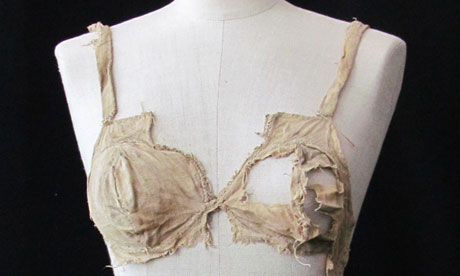
© Associated Press'The Lengberg bras come to us like a secret whispered directly from the past.'
This morning, millions of women have got up and put on a bra - push-up, plunge, balconette, in myriad colours and shapes (the number of sports bras in London is increasing daily). What you do with your breasts when dressing is a question women have dealt with for a good 100,000 years, as long as we've worn clothes. Do you show them, hide them, lift them up, squeeze them together, go au naturel, or turn them into a different shape? They're flexible, functional, and desirable: a prominent feature of femaleness.
The way people dress tells you about their relationship with themselves and their world. It's the reason I'm a clothing historian. How women wrangle their breasts is one of the most intimate and fascinating ways to understand the social concerns of an age. So the
discovery of early 15th-century linen bras in Lengberg Castle, Austria, is a five-line jackpot for dress historians. In her article on the finds in
BBC History Magazine, researcher Beatrix Nutz from the University of Innsbruck elaborates on medieval documentary evidence for "breastbags". She brings to life that people had similar daily concerns to now: enhancing or reducing the bust "so there is no gossip in the city".
Why are these bras amazing? Let me count the ways. First, there is nothing known like them from the Middle Ages. We didn't know they existed, and look how shockingly modern they are. We know medieval women wore linen tunics under their clothing, washable chemises, smocks and shifts that protected outer garments. We didn't know their approach to breast-wrangling except that tight gowns, if cut well, support the bust. Shockwaves are rippling across forums and lists as word spreads of this clothing missing link.
Women stiffened bodices from the late 15th century, which evolved into boned stays creating torsos of smooth, unnatural geometry. There breasts remained for two centuries in sculpted round monobusts. Only with "natural" body fashions around 1800 did lift-and-separate become the
mode du jour, using gussets for each breast. Lift indeed: in 1813 Jane Austen was amused to learn "stays now are not made to force the bosom up at all; that was a very unbecoming, unnatural fashion".
Through the 19th century stays, or corsets as they became known, covered women from bust to hip. When corsets dropped below the bust in the 1900s women wore "brassieres" - short sleeveless camisoles - over corsets to hold everything together and avoid busty muffin-tops. A brassiere may have been patented in 1914 but the word was used from at least 1904. Bandeau brassieres made of narrow straps appeared in the 1910s; the corset disappeared through the 1920s. With the 1930s' slinky bias-cut gowns, the soft, natural brassiered bust made its first appearance since, well, probably since about the time of the Austrian pieces. Similar fit, similar approach to engineering a fashionable bustline.
The very word lingerie is French for "things made from linen". The fibre usually doesn't survive history's long journey. It decays in damp ground, if buried, and above ground suffers meticulous reuse until the last threads became paper. Most surviving medieval linen is royal or a saintly relic. The marvellous collection of everyday medieval textile and clothing pieces excavated from the Thames foreshore and now in the London Archaeological Archive and Research Centre yielded just a few scraps of linen amongst piles of wool and silk outer garments. Any intact medieval linen find is pretty thrilling in itself, and a quotidian one doubly so.
The Lengberg bras, then, come to us like a secret whispered directly from the past. This underwear is the intimacy between inner flesh and clothed outer self, the private pleasures and daily vanities of individual women who were once as real as you and I. They open up doors in the house of the past leading to new and hidden chambers and I, for one, feel an explorers' joy.
The Ol' Busty Muffin Tops faux pas... ;-)
Never heard that one before. Chuckle.
R.C.